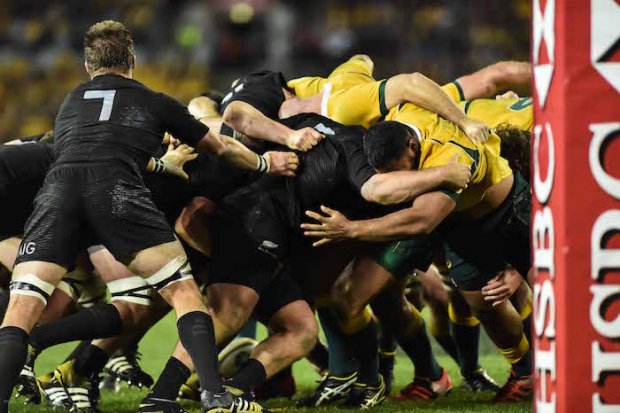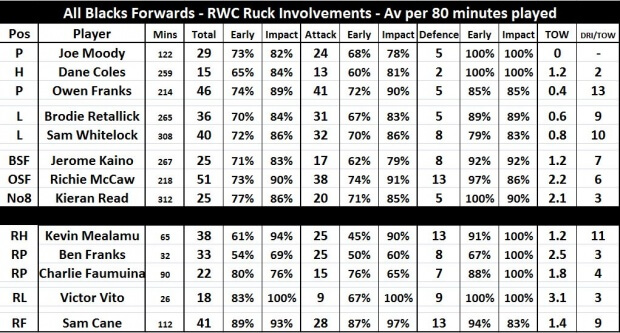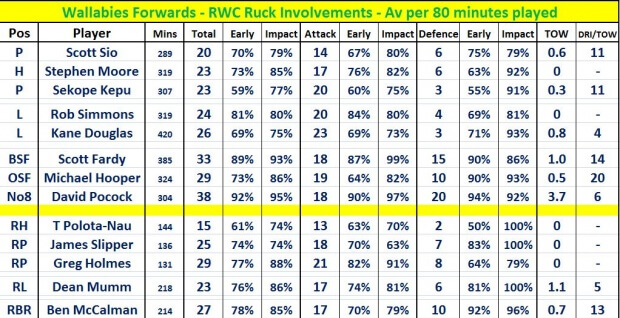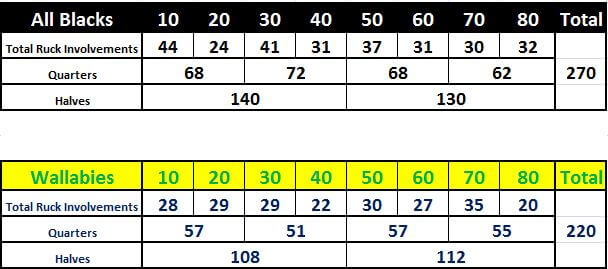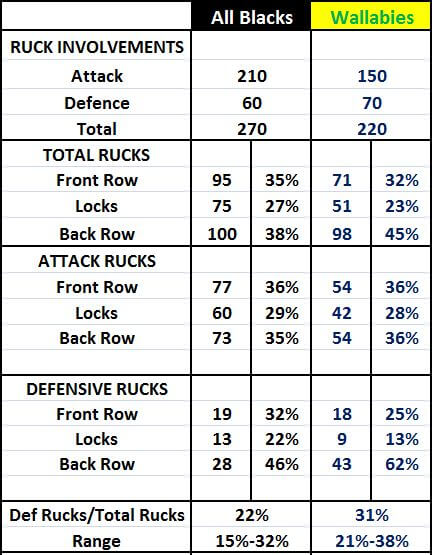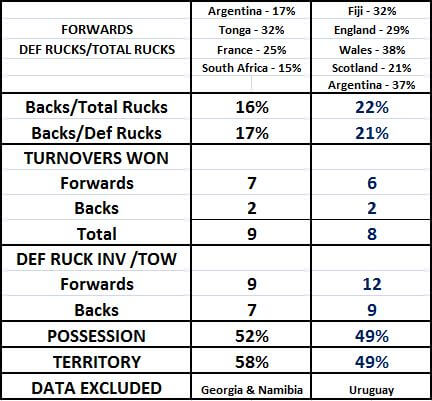Not surprisingly the “Battle at the Breakdown” will be critical to the outcome.
There’s no doubt that the 2 best teams at the RWC have progressed to the Final.
Both teams have shown the best defence and the flexibility and skills to win even when the game doesn’t progress as planned.
In order to make the final, most key players have shown what game they have brought with them or developed for the RWC. For the Wallabies, most players have transferred Ruck Involvements at the SXV level into the Test arena. This is an achievement in itself. Cheika has prepared them well.
The tables below summarises averages so far.
For the Wallabies, the stats show the averages for 5 games. The stats for Uruguay have been excluded as the team comprised mostly of reserves players.
For the All Blacks, ruck stats were not collected for the games against the lesser nations – Georgia and Namibia.
The Ruck Involvement and TOW statistics are normalised to a full 80-minute game. Not all starters last the full game and some replacements have had little more than cameo appearances. However, normalising all data to 80 minutes allows a comparison of work rate.
On FoxSports, in commentary after the Semi-Final against the Pumas, Wallabies great, John Eales, stated words to the effect that the “Wallabies Back Row was the Best in World Rugby”. I reckon he knew that this was a big call. As far as the Ruck Involvement and Turn Overs Won (TOW) statistics are concerned the Back Rows are comparable. This combined with the higher work rates of the All Blacks Front Row, Locks and Forward replacements, give the All Blacks a significant advantage in the Battle at the Breakdown.
The Wallabies Forwards, particularly the Front Row and Locks (including replacements) will need to increase their work rate and ruck involvements to well above their best performances at the RWC to give the Wallabies a chance to win the Battle of the Breakdown and get their hands on The Bill.
RUCK INVOLVEMENTS
Remember:
- Early means 1st or 2nd of player’s team AFTER the ball carrier has been tackled and brought to ground.
- Impact means active engagement: strong physical contact, changed shape of ruck, clean-out, protecting ball etc. (more than hand on someone’s bum or arriving after the hard work has been done). Yes it’s subjective – but as I collect all data at least it’s consistent.
- Impact DOES NOT equate to Effectiveness. I’ve concluded that coming up with an effectiveness measure is just too hard in the time that I have available – but open to suggestions.
Comments:
- All Black Forwards have averaged 270 Ruck Involvements (RIs) per game.
- Wallabies Forwards have averaged 220 RIs per game.
- The 50 additional RIs are evenly spread between the ABs Front Row and Locks and are essentially additional Attack Ruck Involvements (ARIs).
- 5 ABs have RI work rates higher or equal to Pocock – the best for the Wallabies.
- All Black Forwards provide strong support for their team’s ball carriers and appear to be very selective in their Defensive Ruck Involvements (DRIs). All Blacks Back Row are very efficient in earning TOW– averaging 5DRIs/TOW. The Wallabies Back Row averages 9DRIs/TOW.
- Wallabies Back Row has shown itself to be a tight, inter-dependent unit with almost double the DRIs of the All Blacks.
- Pocock is critical to the success of the Wallabies at the breakdown with the highest RIs and more than half the TOW of the starting Forward Pack.
- There is no strong replacement, in either RIs or TOW rate, should Pocock get injured.
- The TOW conversion rate (DRIs/TOW) for Fardy and Hooper are the highest for both sets of Forwards.
- The Wallabies back Row need to work in concert with increased support at Rucks from the Wallabies Tight 5.
- All Backs Front Row replacements provide both strong Ruck Involvement support but excellent TOW outcomes.
- Wallabies Back Row replacements provide reasonable Ruck Involvements support but no TOW in the RWC to date.
- IMO the Wallabies Front Row needs to get out of their comfort zone and work outside of the Central Channel. They need to show more flexibility and desire to get involved in Ruck Involvements out wide. The benefit of this approach is shown in Owen Franks’ RIs which are the 2nd highest for the All Blacks.
- The same is true for the Wallabies Locks. Both of the All Blacks starting Locks average 10 more DRIs than all of the Wallabies Locks.
- The Final is time to leave everything out on the pitch with no regrets.
DISTRIBUTION OF RUCKS OVER 80 MINUTES
Comments:
- The All Blacks obviously have a game plan to unsettle the opposition and to be in the lead by half-time
- The All Blacks apply pressure right from the opening whistle and flood the breakdown for the first 10 minutes (nearly 60% more RIs that normally shown by the Wallabies).
- This pressure is re-applied early in the 2nd quarter and again immediately after the main break.
- The Wallabies have shown that they can sustain RIs over the full game but there has been a marked drop-off in effort for the last 10 minutes of both halves.
RWC BREAKDOWN PERFORMANCE
Comments:
- The All Blacks generally have 50 more RIs than the Wallabies. Their 3% more possession accounts for some of the extra ARIs, however, the All Blacks provide strong support for their own ball carriers and appear very selective in DRIs.
- The extra RIs are evenly distributed between the All Blacks Front Row and Locks.
- All Blacks TRIs: Pumas 260; Tonga 254; France 256; Sth Africa 304.
- Wallabies TRIs: Fiji 185; England 242; Wales 195; Scotland 217; Pumas 263.
- Wallabies Front Row matched the contribution of the Back Row (37% without Pocock) against Scotland
- Wallabies Locks highest contribution was 25% against England.
- Wallabies Back Row lowest contribution was 41% against England.
- The All Blacks generally stand-off Defensive Rucks more than the Wallabies who work harder to slow down the availability of the opposition’s ball.
- The All Blacks have not got close to the 37%/38% DRI involvement shown by the Wallabies against Argentina/Wales.
- The distribution of the Wallabies Forwards’ TRIs is heavily weighted towards the Back Row which has parity with the All Blacks Back Row.
- All Black Backs have less Ruck Involvement than Wallabies Backs. Is this part of the ABs strength in rebounding and scoring from broken play?
- The Average TOW by each team is about the same but the All Blacks are about 30% more efficient in DRI’s/TOW.
- All Blacks Possession: Low – Tonga 42%; High – Bokke 57%, Pumas 58%.
- Wallabies Possession: Low – Wales 40%; High – England 51%, Scotland 55%.
- All Blacks Territory: Low – Tonga 43%; High – Pumas 69%.
- Wallabies Possession: Low – Wales 37%; High – Scotland 62%.
When the Wallabies defeated the All Blacks (27-19) in Bled 1 2015, the Wallabies had 262 TRIs (201A/61D) versus the All Blacks 238 TRIs (174A/64D). Wallabies Forwards DRIs/TRIs was 23% versus the All Blacks 27%. The Wallabies had 56% Possession, 58% Territory and 9 TOW (7F/2B) to the All Blacks 7 TOW (4F/3B). It was very different game to the one that the Wallabies have shown at the RWC.
The 80-minute ‘normalised’ Total Ruck Involvements/work rates in that Test were: Pocock 44 (+6), Fardy 42 (+8), Hooper 24; Horwill 39, Mumm 32 (+9); Sio 17, Moore 28 (+5), Kepu 20. Reserves: Slipper 47 (+12), TPN 47 (+32), Holmes 39 (+10), Skelton 20, McCalman 29 (+2).
These gives some indication of the improvement required to earn a win against the All Blacks.
HOW CAN THE WALLABIES WIN THE BATTLE?
- Don’t rely upon the All Blacks having a bad day. They want this one to give some of their greats a good send-off. Wallabies need to grasp the moment from the opening whistle and leave everything on the field of battle.
- Focus on ball retention with more protection of the Wallabies ball carriers especially from the Front Row and Locks. The Front Rowers in particular have to get out of their comfort zone and work outside the Central Channel.
- Reduce incidence of isolated ball carriers taking the ball into contact to avoid just feeding players such as McCaw Read, Kaino, Whitelock and Retallick.
- Disciplined strategic kicking to gain territory.
- Reduced and more selective involvement in Defensive Rucks to conserve energy for the full 80 minutes.
- Disciplined and fast defensive line.
- Strong Ruck Involvements from Backs, especially Kuridrani, AAC and Giteau, to fill the gaps as required.
- Replacements on at 55-60 minutes to maintain defensive pressure.

